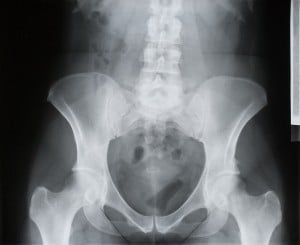

Once upon a time, the ER missed a pelvic fracture in one of my older patients.
Actually, this kind of thing has happened more than once, and perhaps it’s happened to your family too.
As much as we’d like to believe that our older loved ones will get the right care when they are sick or injured, the truth is that our healthcare system is imperfect, and it’s fairly common for serious problems to be missed.
Unless, of course, a proactive family caregiver knows to help the doctor focus on what’s newly wrong.
Here is a true story about why geriatricians pay attention to “changes in function” and why it’s essential that you help doctors spot any changes in function or ability.
The case: unable to walk after a fall
My patient with Alzheimer’s dementia, 85-year-old Mr. C., sat down short of his easy chair at home and fell. Within minutes, his daughter found him on the floor. She helped him to the chair, and they watched some TV. But half an hour later, he was unable to get up again and walk. She took him to the emergency room for evaluation.
“I’m fine. Nothing hurts,” Mr. C. told the busy ER staff more than once. “I just want to go home.” X-rays of his hips and pelvis revealed nothing, and so — after an exam that probably lasted only a minute or two — he was discharged.
Back home, however, he still couldn’t walk. He still insisted nothing hurt. “I’m a tough old bird,” he told his daughter. Later that night, though, she noticed that he grimaced every time he rolled over in bed. She knew something was wrong. But what?
The challenge: ageism and busy health providers
There are few things more frustrating than bringing your loved one to see doctors when you know something’s wrong, only to be told, “Everything’s fine.”
Often everything is fine, thank goodness. But sometimes, an important problem gets overlooked. Unfortunately, one group — frail older people with Alzheimer’s or another dementia — is especially likely to be dismissed as “okay” when they’re not.
Why? Because people with dementia aren’t accurate self-reporters, and their caregivers often inadvertently neglect to report information about their status in a way that most healthcare providers understand.
There’s also, to be honest, an issue of ageism here. Many health providers will inappropriately assume it’s “normal” or an 85-year-old person’s baseline, not to be able to walk. This means new problems and changes in functional status can easily be overlooked.
The solution: Know what to look for — and what to say
The good news is that by understanding a key concept in geriatric care, a proactive caregiver can dramatically improve the odds of getting the right answers when bringing someone with dementia to urgent care or the emergency room.
The key concept is this: Changes in mental or physical function are critically important. Be sure to mention them — because they almost always deserve further evaluation.
Example 1: Let’s say your aging mother with dementia is usually forgetful and confused about the month but consistently recognizes familiar people. If one day she’s much more confused than usual — not even recognizing the faces she sees every day — that’s a change in mental function. It could represent delirium (a sudden state of mental confusion and changes in brain function that can have many different causes). It should definitely be brought to the attention of a medical professional. Urinary tract infections, for instance, can cause delirium in older people.
Example 2: You’re caring for an elderly father with Parkinson’s who’s often a bit confused and unsteady. If he’s normally able to walk but, after a fall, he can’t, even unsteadily, that’s an important change in physical function.
So it was with Mr. C. Although his daughter had dutifully reported to the ER doctors that her father had fallen, she hadn’t emphasized that he was able to walk just fine until he fell. And because Mr. C. has moderate dementia, he was unable to articulate the pain that rendered him unable to take a step. Fortunately, after they returned home, the daughter was worried enough to call our Geriatrics Clinic, where Mr. C. was a patient. (He also has a heart condition.)
When we realized there had been a change in his function, we had him brought in for a CT scan of his pelvis, and we found several hairline pelvic fractures.
Diagnosing these hairline fractures allowed us to make a better plan to manage Mr. C.’s pain, so that he could keep walking a bit while his pelvis slowly healed. By doing this, we kept him from becoming bed-bound, which would’ve seriously decreased his quality of life and increased his daughter’s work in caring for him.
Changes in function seem like such a commonsense symptom that many family caregivers assume doctors will note these changes and take them seriously.
Unfortunately, it’s very easy for changes in function to slip under the radar of busy doctors, especially if they aren’t trained in geriatrics (the specialty of medicine that focuses on aging adults), and especially when patients and families don’t explicitly point out the changes.
You should also alert the doctors if your older loved one develops any new or increased difficulties with ADLs or IADLs. (You can learn more about those here: What are Activities of Daily Living (ADLs) & Instrumental Activities of Daily Living (IADLs)?)
Tips for Family Caregivers
Always report any notable change in someone’s physical or mental functioning to a doctor, no matter how obvious it seems to you. Be sure to specify when you noticed the change, and how quickly it seemed to come on.
And then insist on getting an answer to what could be causing that change.
